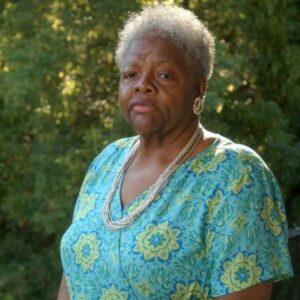Dr. Ella Sims
Life Dates: b. 1924, d. January 23, 2013
Full Name: Dr. Ella Mary Sims
Birthplace: Summer, MS
Tags: Community Organizations, Government Service, Women’s Clubs, Oral History
In 1924, Ella Sims was born in Summer, Mississippi and went to a one-room school house until she was 15. Then she “went across the river on a ferry boat to Helen, AR, and stayed with relatives” in order to attend high school.
Ella’s father was a Baptist minister and her mother was disabled as a result of polio. She died when Ella was almost 15 years old. The family moved often around the State of Arkansas. Ella was the middle child of three daughters. She also had two step-brothers from her father’s first marriage. According to Ella, everyone worked in the cotton fields “from sun up to sun down.” She also noted that she “played the role of a boy for [her] dad” and did not learn how to cook until after she was married and learned from her mother-in-law.
The three sisters sang in church. By 12 years old, Ella was also writing her own papers and speeches and presenting them in church. Her social life consisted of church, annual revivals, and big picnics. When she was only nine years old, Ella said she was “saved,” a very memorable event for her as she remembered the exact date: August 11, 1933. From that date, the motivating factors in her life were service and a belief in life after death.
At the age of 17, Ella got married and had a son who died in 1944 when he was only 10 months old. Another son, Jimmy, was born the next year on September 28. In December 1945, her husband died. Because she was so despondent over her losses, Ella’s doctor recommended she get away for a little while. She had a cousin in Grand Rapids, MI, so Ella came for a visit in March 1946. She never went back to Helen, Arkansas. That same year, she met her second husband and was married in 1947. They were married for 20 years and had nine children.
In Grand Rapids, Ella became active in her church and the children’s school. She said she raised both her own seven children and also the neighborhood children. In the 1960s she was the PTA president and served on many boards of city organizations. She learned her leadership skills in grassroots organizations from her involvement in the Office of Economic Opportunity. Ella called herself a “product of OEO [poverty] programs.” One example is Ella’s service as a volunteer and then board member of Kent County Community Action Program, advocating on behalf of the poor. She served on the board from 1965 to 1974.
Another example is her many years of service as a founding member and vice president of the Aquinas College Women’s Resource Center’s (WRC) board. She was one of two black women founders. (The other one was Shirley Perkins.) Ella also helped get funding for this project through the Kellogg Foundation, which at the time was focusing on minority poverty. Reflecting on this experience, Ella said she “learned a lot” about the differences between blacks and whites in working in groups. Because of her work on the WRC board, the president of Aquinas College at the time, Norbert Hruby, asked her to join the college board of directors.
Ella concluded that throughout the years of serving on several boards, she was often the only black person and the only woman on them. Nevertheless, she would serve only if she could actively participate in the work of the board. For instance, Ella was on the Right to Life board. She rarely attended meetings, and yet because of “her name,” she was asked to remain on the board. After 6 years, she sent a resignation letter, saying she wanted to do more than just be a name on a list.
In addition to serving on two boards at Aquinas College, in January 1976, Ella was hired as the director of minority student affairs at Aquinas to support the first group of 125 minority students to come to the college. As a result of a million-dollar grant awarded to the school the previous year, these students had been recruited from across the country. The recruiter who had also acted as a counselor had departed for another job. By the time she became the program’s counselor, 40 students had already left and the 85 who remained were “fighting” among themselves, according to Ella. First, she organized cars, so the students could get off campus on the weekends to attend church or socialize with other young black people. She helped them connect with black alumni mentors. Furthermore, she recruited local black donors and local black students for the program.
Ella Sims made history as the first woman of color columnist for the Grand Rapids Press, with her column “It Seems to Me.” She also worked with Grand Rapids community organizations such as the NAACP, YWCA, the Family Outreach Center, the Salvation Army, and the Michigan League of Human Services.
Sources
This biography is adapted from a summary of a transcript of an oral history interview with Dr. Ella Sims. Learn more about Grand Rapids women’s oral histories here.
Thoms, Sue. “Ella Mary Sims: From sharecropper’s daughter to community activist, she was known as woman of great faith.” MLive, February 5, 2013. https://www.mlive.com/news/grand-rapids/2013/02/ella_mary_sims_from_sharecropp.html.

